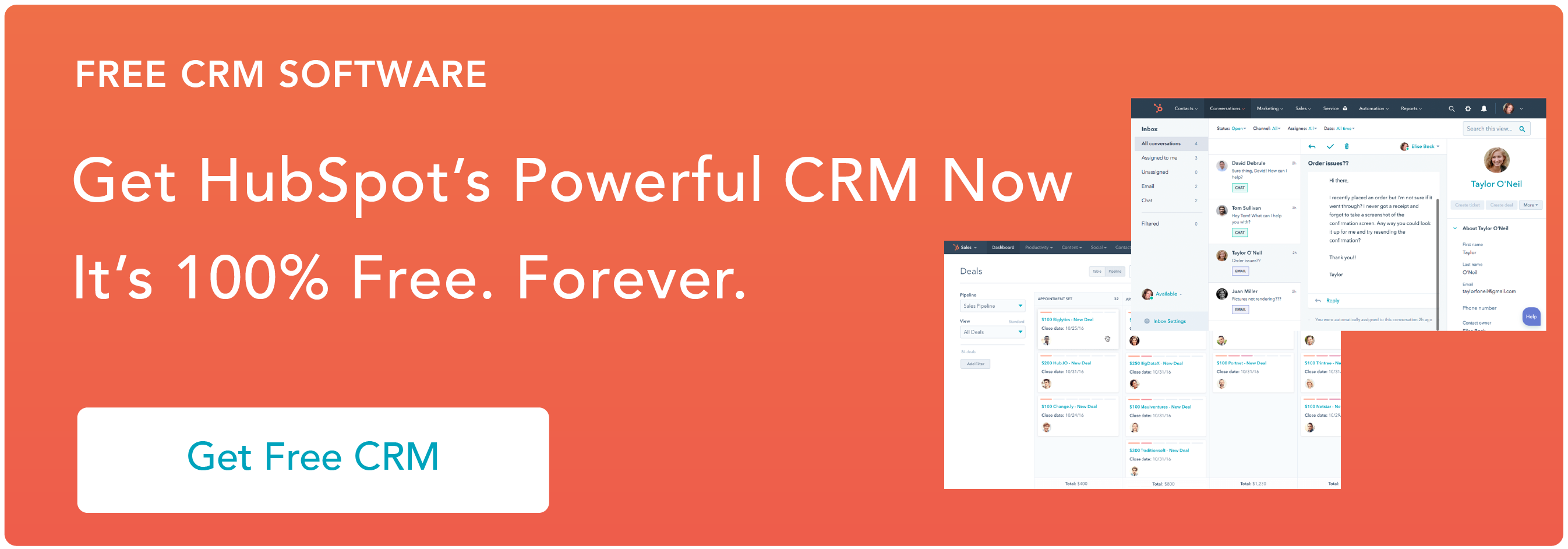
While you first begin out in enterprise, you possibly can most likely handle to maintain your entire clients top-of-mind since you don’t have that many, so sticky notes are your finest good friend.

As your buyer base grows, nonetheless, buyer relationship administration (CRM) instruments are crucial to preserving observe of key information. The caveat? Even best-of-breed instruments gained’t bolster enterprise with out the appropriate CRM technique.
On this piece, we’ll begin off with a fast refresher on CRMs and CRM technique, then provide a step-by-step information to getting began together with real-world examples.

A Refresher on CRMs
What’s a CRM technique?
How do you develop a CRM technique?
6 Steps To Create a CRM Technique
3 Examples of CRM Methods That Work
A Refresher on CRMs
A CRM is a customizable know-how that lets you maintain observe of your entire clients’ interactions with what you are promoting, from the primary time they go to your web site to the final time they made a purchase order.
CRMs embrace particulars like buyer contact data, their shopping for preferences, and notes from each dialog you’ve had with them.
You possibly can tailor the knowledge you enter and retain it in your CRM nonetheless you’d like. You need to acquire as little or as a lot data as will assist you to serve your clients and convert prospects extra effectively.
Buyer relationship administration is simply that…managing relationships along with your clients. You’ll see quite a lot of advantages in what you are promoting when you incorporate a CRM. These embrace the next.
1. Happier Clients
A CRM shops a buyer or prospect’s digital interactions along with your firm. It may well see the blogs they learn, the emails they opened, and the pages on the web site the place they lingered.
This enables messaging and presents to be tailor-made to the client. Clients obtain data concerning merchandise they really want and aren’t bothered with what they don’t.
2. Increased Productiveness
Each second your salesforce spends on administrative duties is time away from prospects. With automated duties like name and exercise reporting, your salespeople can spend extra time doing what they do finest.
Plus, they will set notifications as to when they should observe up with prospects. They will additionally view notes with private data they gathered throughout an interplay, to allow them to personalize the subsequent dialog.
3. Elevated Teamwork
Maybe your salespeople don’t work alone. Perhaps you will have a gross sales growth rep (SDR) who spends their days prospecting and qualifying leads earlier than passing them alongside to an account govt (AE).
This software improves communication and permits the handoff to be streamlined and environment friendly. It additionally helps if you’ve obtained a salesman on trip and a workforce member must observe up on a lead.
4. Arduous Numbers
Have to know the way your salespeople are doing? You’ll obtain information on their conversion charges, common deal dimension, time to shut, and way more.
As you develop and tackle extra prospects and clients, a CRM may be your lifeline. However provided that you utilize it proper.
What’s a CRM technique?
-jpg.jpeg)
Let’s say that you just needed to hold an image in your front room. You’re taking a nail and line it up on the wall. Then, you seize a hammer and whack on the nail with the deal with when you maintain the top of the hammer.
You wouldn’t be hanging any footage that manner. Likelihood is, you’d should restore the drywall as well. Even worse, what if in case you have a hammer however depart it within the toolbox and simply hit the nail along with your hand?
You’ve obtained the appropriate software, so why isn’t it working? Since you aren’t utilizing it correctly (or in any respect). With out a technique, no software on the planet will likely be proper for the job it’s essential to do. The identical goes for a CRM.
So, what’s a CRM technique?
A CRM technique is a plan that your total firm adopts to assist improve productiveness, effectivity, and earnings. It’s an organization-wide perception that clients are the lifeblood of what you are promoting. Constructing relationships with them and nurturing these relationships is the quickest path to success.
Ideally, you’ll develop this technique prior to buying your CRM software program. It will mean you can select the instruments, capabilities, and value level that’s finest for what you are promoting.
With out a technique, your staff might turn out to be overwhelmed by all of the potential capabilities and fail to make use of your new software in any respect.
How do you develop a CRM technique?
A CRM technique has all the things to do along with your firm and your wants. The technique (identical to the software itself) just isn’t a one-size-fits-all resolution. That’s why it’s so vital to take your time growing a CRM technique.
Earlier than you get began, you’ll want to find out three issues:
- What are you hoping to perform? What targets have you ever set for the corporate? What do you need to get out of your CRM?
- Who’re your clients? What does your perfect buyer seem like and the way do you attain them?
- What does their purchaser journey seem like? This present day, clients can work together along with your firm in a number of methods. You’ll possible have totally different purchaser journeys relying on the kind of buyer you’re working with.
6 Steps To Create a CRM Technique
You’ve accomplished the work and have a greater understanding of your organization, your clients, and your wants. Now, you’re able to develop your technique.
Whereas the precise wants of each model and enterprise will differ, the next six steps can get your CRM technique off on the appropriate foot.
1. Onboard your staff.
Even the best CRM solutions won’t deliver on their potential if staff aren’t on board with the change.
Help your employees understand why they’re using a CRM and the benefits for them and their customers. When they grasp how much easier it will make their jobs and how much more successful they can be, they’ll be eager to use it.
Best bet? Start with a trial run. Bring in the new tool and let staff explore how it works, what it offers, and how it will change current processes. This last point is the most critical — process familiarity plays a large role in determining which tools are used and how. By giving staff time to understand the new solution, you can set yourself up for strategic success.
It’s also worth getting their feedback on where the system excels and how it could be made better.
2. Provide the proper training.
Next up is training. This is important no matter the type of CRM you implement — even simple, easy-to-use solutions may not naturally integrate with existing processes.
Giving staff the knowledge they need to make the best use of your new CRM is a critical part of the long-term strategy.
3. Establish your brand voice.
The CRM platform can be used to communicate with customers. You can customize email messaging and other content from the beginning of the prospect’s journey all the way through the customer’s lifecycle.
That’s why it’s so important to decide early on what your tone and communication style will be. Are you casual or formal? Humorous or straightlaced? Determine this at the beginning and make sure that every employee understands the expectation.
4. Identify your KPIs.
You need to clearly define your key performance indicators (KPIs) and then communicate them clearly to your team. This ensures that everyone knows what’s being tracked and how it will factor into their performance assessments.
For example, your priority might be generating new customer leads over a specific period of time. Data from CRM tools can provide insight into how many leads teams currently have. Then each month, managers can reassess this data to determine overall trends.
If the number of leads is going up, sales prospecting processes are working. If numbers are trending down, changes may be required.
5. Decide who is doing what.
With any team, responsibilities must be clearly assigned so no one thinks someone else is handling them. Figure out who will own what roles within the CRM system and then communicate them clearly to the individuals involved.
In practice, this could mean assigning members of your IT team the responsibility for maintenance and management of CRM tools in your network, along with designating backup support if these individuals leave the company.
You can also assign different roles, such as data input or analytics, to specific staff members to ensure work isn’t duplicated.
6. Conduct regular reviews.
Your CRM strategy isn’t static. Instead, it needs to change over time as sales volumes grow and customer expectations change. By setting a regular review schedule, typically every 4-6 months, you can assess how current strategies are performing and if changes are required.
3 Examples of CRM Strategies That Work
Remember, there is no cookie-cutter CRM strategy that will work for every business. However, there is a world of CRM strategy examples out there you can learn from and be inspired by.
Do a bit of digging and you may find a company in a similar industry, but perhaps a different market, you can emulate. Or, you may find an entirely different business out there whose strategy can be tailored to fit your needs.
Let’s take a look at three examples.
Airbnb saves with automation.
Customers are assisted through automated communications during their buying cycle which limits the contact between employees and customers to streamline the experience. In most situations, no employee–traveler interaction is necessary.
-jpg.jpeg)
It uses its CRM to:
- Suggest comparable accommodations in the area by email when a customer is searching.
- Retarget the customer through Facebook ads.
- Send notifications through email, SMS, and the app during the reservation process.
- Email the customer once the reservation is made to encourage them to become an Airbnb host and rent out their own home while they’re away.
- Send a survey after their trip to evaluate the accommodations.
This automation frees up employees to focus on building brand awareness and strengthening the Airbnb community.
Why this works: Automation reduces the risk of incorrect or duplicate data in your system. This both increases accuracy and reduces the amount of manual effort required.
Sephora creates community, inspires loyal customers, and sells them what they actually want.
While many companies have created loyal followers, no one does it quite like Sephora.
- Sephora takes the time to get to know its customers and then uses its CRM to track this information. This allows the brand to segment its customers into different groups and target them with personalized offers.
- The company fosters an online community, allowing customers to interact with both the company and fellow beauty enthusiasts.
- Sephora then encourages customer engagement and purchases with a tiered loyalty program. It rewards its most loyal customers with personalized gifts, offers, and discounts. With three levels, it has created excitement and exclusivity around its loyalty program which helps to boost sales and retain customers.
And it couldn’t do any of it without its CRM.
-jpg.jpeg)
Why this works: Using CRM data to understand what customers want makes it possible to both improve customer lifetime value (CLV) and understand emerging sales trends.
Wells Fargo manages customer feedback.
With so many ways to contact the company, Wells Fargo uses its CRM to respond quickly to comments and complaints and then logs the conversations in the customer’s record. For example, when a customer comments on one of the company’s social media accounts, a customer service agent is notified and can formulate a response in real time.
Their CRM connects platforms to streamline communication and provide better customer service.
Why this works: Connecting a number of touchpoints by way of CRM offers a solution to achieve complete buyer visibility. This reduces frustration since clients don’t want to elucidate their situation time and again to brokers. You possibly can then scale back the period of time clients are saved ready for service.
Strategically Talking
CRM instruments provide a solution to transfer from sticky notes to complete buyer information storage, in flip making it simpler to search out the knowledge it’s essential to maintain clients joyful.
However making the perfect use of those instruments requires the appropriate CRM technique. Merely implementing a CRM and hoping for the perfect might present preliminary advantages, however these will taper off over time until CRM deployments are backed by the appropriate technique.
Fortunately, the method isn’t sophisticated. First, onboard staff after which present them with correct coaching. Subsequent, set up your model voice and choose your KPIs. Lastly, assign duty for duties and recurrently evaluate your CRM technique to make sure it’s preserving tempo with buyer expectations.

-jpg.jpeg) Image Source
Image Source